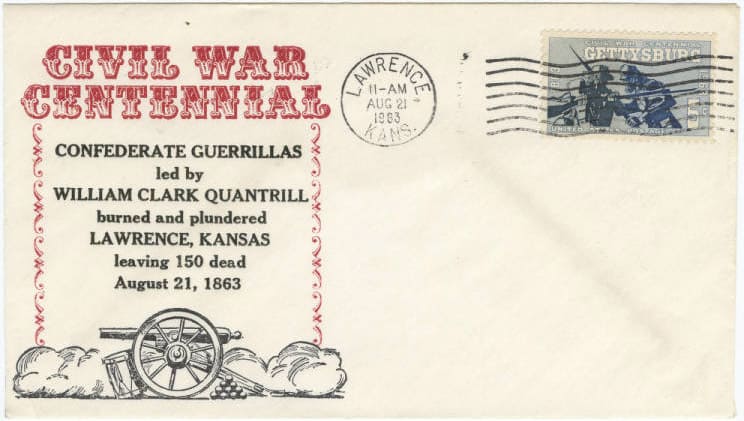
Civil War Centennial cover with a Gettysburg 5-cent stamp. Postmarked Lawrence, KS 08/21/1963 11 a.m. Courtesy of the Missouri State Archives, MS456 James Sullivan Civil War Collection.
August 16, 1863 – September 5, 1863
By Phil Kohn
Phil Kohn can be reached at USCW160@yahoo.com
On August 16, 1863, U.S. Maj. Gen. William Rosecrans resumes his offensive against Confederate Gen. Braxton Bragg by moving his Army of the Cumberland from Tullahoma, Tennessee, towards the Tennessee River and Chattanooga. The same day, U.S. Maj. Gen. Ambrose Burnside begins moving his men from Lexington, Kentucky, towards eastern Tennessee. The intent is to catch Bragg’s force between them. Aware of the Union movements, Gen. Bragg calls for more troops.
Union soldiers sent from Vicksburg, Mississippi, and Memphis, Tennessee, converge on Grenada, Mississippi, on August 17, to destroy railroad stock and supplies. On the same day, Federal land and naval forces begin shelling Fort Sumter, in Charleston Harbor, South Carolina. The fort’s brick walls begin to crumble before the heavy bombardment, but the resulting mix of debris and sand provides even more protection from the Federal guns.
In Washington, D.C., on August 18, President Lincoln fires a few test rounds from the new Spencer repeating rifle that will soon give Union soldiers a decided advantage over the Confederates’ single-load weapons. The Spencer holds seven bullets in a magazine and can fire at the rate of 14 rounds per minute versus about two to three rounds per minute for a single-round, muzzle-loaded piece.
Union troops on August 19 destroy a Confederate saltpeter works at Franklin, Virginia. Saltpeter (potassium nitrate) is used to make, among other things, black-powder ammunition.
Col. Christopher “Kit” Carson on August 20 leads Federal troops based in the New Mexico Territory on a campaign against the Navajo, who have been engaging in depredations against settlers in the Arizona Territory. The goal is to remove them from their stronghold in Canyon de Chelly, Arizona Territory, and move them to a reservation at Bosque Redondo in New Mexico Territory.
At 5 a.m. on August 21, some 450 Confederate guerrillas led by Capt. William Clarke Quantrill attack the abolitionist stronghold of Lawrence, Kansas. The raiders kill 150 unarmed men and boys, sparing only women and smaller children. By 9 a.m., when they depart, they have looted and then burned the town, causing over $1.5 million in property damage. One of the main targets of the raid, abolitionist U.S. Sen. James Lane, escapes by running into a corn field in his pajamas. Ostensibly in retaliation for the jail-building collapse on August 14 that killed and severely injured female relatives of the raiders, the raid is believed to have been planned prior to the jail collapse. In Tennessee, troops of Maj. Gen. William Rosecrans begin shelling Gen. Braxton Bragg’s Confederates at Chattanooga.
On August 22, the huge Union cannon called the “Swamp Angel” — actually an 8-inch Parrott rifle — begins firing 200-pound incendiary shells at Charleston, South Carolina, from the marshes of nearby James Island. The artillery piece explodes during the firing of its 36th round. The first 35 rounds cause little damage. Says an observer later: “The [gun] turned out to have been more destructive to Union gun crews than to Rebel property.”
In Indian Territory, 4,500 well-equipped Union troops under Brig. Gen. James Blunt are continuing to pursue the poorly armed and outnumbered Confederate force that they had defeated at Honey Springs, Cherokee Nation, in July. On August 23, the Federals catch up to and again engage the Confederates at the important supply depot of Perryville, on the south side of the Canadian River in the Choctaw Nation. The Southern force is now led by Brig. Gen. William Steele, commandant of Indian Territory, who has come from his headquarters at Ft. Smith, Arkansas. Overwhelmed by superior artillery and the Federals’ highly accurate and faster-firing, breech-loaded, magazine-fed Sharps rifles, the Confederates hasten their retreat southward toward Texas. After burning the supply depot, Blunt, instead of continuing the pursuit, turns his force eastward and heads toward Ft. Smith, Arkansas.
Fort Sumter, in Charleston Harbor, South Carolina, by August 24 has endured eight days of bombardment by Union artillery. The 5,009 shells fired at Sumter have caused few casualties and, although the fort’s brick walls are crumbling, there are no exploitable breaches. President Jefferson Davis summons Gen. Robert E. Lee to Richmond, Virginia, for consultations. The Confederate chief executive wishes Lee to move toward Chattanooga to assist Gen. Braxton Bragg’s Army of Tennessee, which is falling back before the Union force of Maj. Gen. William Rosecrans. Lee convinces Davis that he should remain in Virginia.
Partly in retaliation for the so-called “Sack of Lawrence” on August 21 and partly out of frustration over continuing partisan raids, U.S. Maj. Gen. Thomas Ewing, Jr., on August 25 issues General Order Number 11 that mandates the forced removal of civilians in four “secessionist counties” in Missouri east of the Kansas border. Federal soldiers burn homes, barns and crops in the designated area, near Kansas City, leaving an estimated 20,000 people homeless, destitute and displaced. The mandate and subsequent destruction have little effect in stopping guerrilla activity, and resentment against Ewing and the federal government lasts for years in and around the area of Missouri that comes to be known as “the Burnt District.”
In South Carolina, on August 29, the Confederate experimental submarine CSS H.L. Hunley sinks in Charleston Harbor during a test cruise, drowning five crew members. The vessel is subsequently raised and work on it continues.
On August 30, 1863, Federal batteries around Charleston, South Carolina, resume a heavy bombardment of Confederate-held Fort Sumter.
On September 1, a Federal force under Maj. Gen. Frederick Steele captures Ft. Smith, Arkansas, in the northwestern corner of the state, after Confederates evacuate the town. Ft. Smith had housed the headquarters of the Confederate Department of the Indian Territory. In eastern Tennessee, Maj. Gen. Ambrose Burnside’s Union troops, who left Lexington, Kentucky, in August, capture Kingston, Tennessee, unopposed by any Confederate resistance. In Charleston, South Carolina, Federal artillery pours over 600 rounds into Fort Sumter, in the middle of Charleston Harbor, further reducing the fort’s walls but not dislodging its Confederate defenders.
Two days later, on September 3, Federals under Maj. Gen. Burnside take Knoxville, Tennessee. The occupation cuts the rail link between Chattanooga, Tennessee, and Virginia.
Maj. Gen. Ulysses Grant, in New Orleans, Louisiana, for a meeting is involved in a riding accident on September 4; his horse falls on him, partially incapacitating him for the rest of the month. Near Chattanooga, Tennessee, Maj. Gen. William Rosecrans completes the four-day crossing of the Tennessee River by his Army of the Cumberland. Expecting — but not receiving — resistance, Rosecrans suspects that Gen. Braxton Bragg and his Confederates are fleeing into Georgia. In Mobile, Alabama, dwindling supplies of food and clothing trigger protests, rioting and looting by women of the city.
The British government, finally responding to U.S. protests, on September 5 seizes two ironclad rams being built at Liverpool that had been ordered by the Confederacy. The seizure ends England’s contributions to Southern naval power. In Tennessee, Maj. Gen. William Rosecrans — now convinced that Gen. Braxton Bragg is evacuating Chattanooga — orders his Federal force into the mountains of northern Georgia in pursuit of the Confederates. To enable them to move more quickly, he divides his troops into three sections, which will advance through three widely spaced passes in the mountains.







